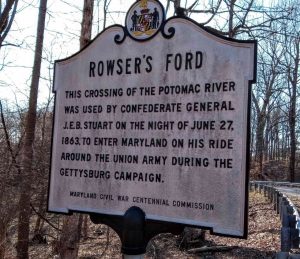Civil War in Montgomery County and the Region
Request one of the following Speakers Bureau topics through our online form!
Questions? Contact Matthew Gagle or call 301-340-2825.
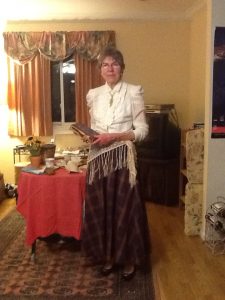 We Were There, Too: Nurses in the Civil War
We Were There, Too: Nurses in the Civil War
Reenactor: Candace Ridington
Candace Ridington portrays a nurse reminiscing about her time of service in Washington, D.C., during the Civil War when the nursing profession struggled to create itself. This reenactment portrays the nurse profession’s early challenges, its rewards and sadness, and a glimpse of other nurses whose names are known to us through their journals. Suitable for adults and young adults. 45-50 minutes.
*In-person Only*
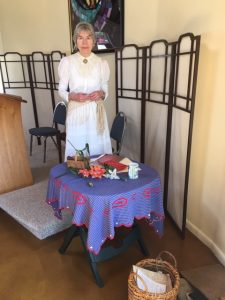 The Underground Railroad Movement: Riding the Freedom Train
The Underground Railroad Movement: Riding the Freedom Train
Reenactor: Candace Ridington
Learn about the Underground Railroad Movement by seeing short dramatic portraits of those involved (and some opposed), both anonymous and known. The presentation shows the work by blacks and white alike to aid and save enslaved people. Candace Ridington portrays all of the characters using a mix of props and clothing alterations. Some narration fills in the material and moves events relentlessly to Civil War. This program lasts about 45 to 50 minutes, is suitable for adults and young adults, and could be used in classrooms.
*In-person Only*
 Songs and Stories from the Blue and the Gray
Songs and Stories from the Blue and the Gray
Speaker: Patrick Lacefield
Join this descendant of Civil War veterans, who shares songs and stories from the War Between the States, wearing both blue and gray, and accompanying himself on guitar.
*In-person Only*
On the night of June 27, 1863, Confederate General J.E.B. Stuart crossed the Potomac River with 5,000 horsemen including artillery at “Rowser’s Ford” and proceeded to ransack Montgomery County. Stuart’s actions proved a catastrophe for the Confederacy because he should have been with Robert E. Lee’s army in Pennsylvania. Moving blindly without his cavalry, Lee stumbled into the huge Union army at a place called Gettysburg where he was soundly defeated. To deflect criticism, Stuart wrote a report glorifying his crossing at Rowser’s Ford as a heroic, superhuman effort. In more recent times, markers have been erected at the supposed site on the C&O Canal at Violette’s and Riley’s locks. Visitors marvel at the courage of Stuart and his men to cross the mile-wide river, filled with rocks, rapids, and whirlpools. But the markers, and history, misplace the site. It was actually two miles downriver in a placid, sandy-bottomed part of the Potomac on John Rowzee’s farm. Jim Johnston unravels the historical mystery.
 The Better Angels: Five women who changed – and were changed by – the American Civil War
The Better Angels: Five women who changed – and were changed by – the American Civil War
Speaker: Robert Plumb
A presentation in PowerPoint format about five remarkable women who made important contributions to the Union cause at various stages before, during, and after the critical years of the American Civil War. The singular actions of Clara Barton, Julia Ward Howe, Sarah Josepha Hale, Harriet Beecher Stowe, and Harriet Tubman led to their prominence during the war, and launched them into successful public roles following the conflict. Plumb will cover highlights of the women’s contributions, their legacies, and their defining qualities such as courage, self-assurance, and persistence that led to their successes. Plumb’s newest book, The Better Angels, will be published by Potomac Books, an imprint of University of Nebraska Press, in March of 2020.
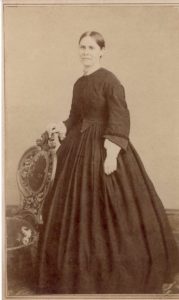 Divided Nation, Divided Town: One Woman’s Experience
Divided Nation, Divided Town: One Woman’s Experience
Speaker: Emily Correll
The story of Rockville’s Dora Higgins and her experiences during the Civil War. Based on a letter that Dora, an ardent abolitionist, wrote to her mother describing her trials as rebel general J.E.B. Stuart’s men came through Rockville and captured her husband. Rockville’s divisions over slavery and the war can serve as an illustration of the divisions in Maryland and the United States as a whole.
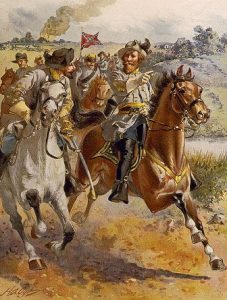 J.E.B. Stuart’s “Wild Ride” Through Montgomery County
J.E.B. Stuart’s “Wild Ride” Through Montgomery County
Speaker: Robert Plumb
On June 28, 1863, Confederate General J.E.B Stuart and his three cavalry brigades crossed the Potomac River and arrived in Montgomery County. For the next two days, Stuart’s cavalry engaged in several actions that would, in varying degrees, hinder and delay their movement north to join the Confederate forces in Pennsylvania. First, Stuart’s army demonstrated their control of Rockville by rounding up Union officials and taking them prisoner. Next, was an encounter between some of Stuart’s soldiers and the students of a female academy in Rockville, thus delaying the army again. Lastly, Stuart’s army captured and controlled a large Union wagon train laden with supplies, which became a significant impediment to Stuart’s expeditious travel onward to Pennsylvania. This is a PowerPoint lecture.
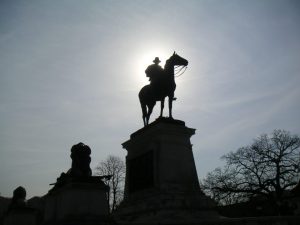 A Field Guide to Civil War Statues in Washington
A Field Guide to Civil War Statues in Washington
Speaker: James H. Johnston
In recent years, America has commemorated valor by erecting monuments to entire wars, such as the World War II and the Vietnam Veteran’s Memorials. Civil War veterans did it differently. They remembered themselves in monuments through their generals. Jim Johnston uses the statues to tell the story of the Civil War and of the artistry that went into them.
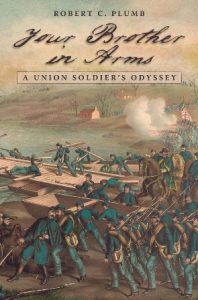 The Odyssey of a Civil War Soldier
The Odyssey of a Civil War Soldier
Speaker: Robert Plumb
George P. McClelland served with the 155th Pennsylvania Infantry, Army of the Potomac, from August 1862 to his discharge in June 1865. Author Robert Plumb reads from McClelland’s letters and narrative excerpts from his book, Your Brother in Arms, which offer a front-line soldier’s view of some of the most crucial battles fought during the Civil War– from Gettysburg to Petersburg. Literate and evocative, the letters convey an authentic perspective of a soldier who experienced one of the bloodiest and most transformative wars in American history. This is a PowerPoint presentation.
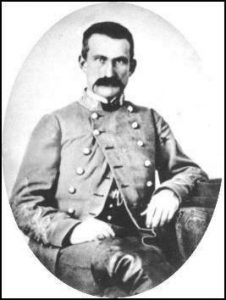 The Man Who (Almost) Conquered Washington: Gen. John McCausland
The Man Who (Almost) Conquered Washington: Gen. John McCausland
Speaker: James H. Johnston
Confederate General John McCausland bragged to Ulysses Grant that McCausland had come closer to taking the city than any other Confederate general. Was he right, or was he just telling another tall soldier’s tale? And then there’s that “Chambersburg thing.” His grandson didn’t want to talk about it. McCausland had the city burned down.
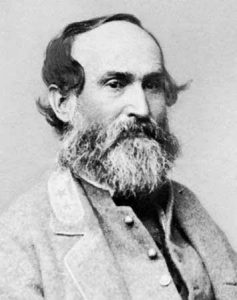 Jubal Early’s Attack on Washington
Jubal Early’s Attack on Washington
Speaker: James H. Johnston
In early summer 1864, the Union’s prospects for victory in the Civil War brightened when Union General Ulysses Grant besieged Richmond. But on July 10, Confederate General Jubal Early rode into Rockville with 15,000 men headed for Washington D.C. The city was in panic. Spoiler alert: Washington didn’t fall. But what was Early’s aim, and how close did he come to taking the city and ending the war?
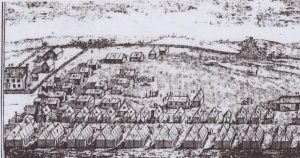 The Civil War Camps at Muddy Branch and the Outpost Camp and Blockhouse at Blockhouse Point
The Civil War Camps at Muddy Branch and the Outpost Camp and Blockhouse at Blockhouse Point
Speaker: Don Housley
Between 1861 and 1865, some 29 Union regiments from 13 states stationed at Muddy Branch guarded the Chesapeake and Ohio Canal and the Potomac River crossings in the general area between Seneca and Pennyfield Locks. To serve as early warning stations on bluffs overlooking the Potomac, Union troops built a series of blockhouses. Archaeological work is continuing on the only blockhouse now located on county park land at Blockhouse Point. This PowerPoint presentation covers both the Civil War history of the camps at Muddy Branch and the history and archaeology of its outpost blockhouse and camp located within Blockhouse Point Conservation Park. A follow up guided tour of the blockhouse and outpost campsite can also be arranged.
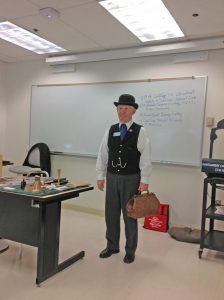 Union Army Surgeon Dr. Edward Stonestreet & His Civil War Hospital in Rockville
Union Army Surgeon Dr. Edward Stonestreet & His Civil War Hospital in Rockville
Speaker: Clarence Hickey
Dr. Edward Stonestreet of Rockville served as Montgomery County Examining Surgeon in 1862, performing physical examinations on local Union Army recruits and draftees. He also served two terms as Acting Assistant Surgeon with the Union Army. He was in charge of a temporary Army General Hospital in Rockville, treating the wounded after the Battle of Antietam (1862), and also treated the ill soldiers of the 6th Michigan Cavalry Regiment in Rockville (1863) prior to its heroic efforts during the Battle of Gettysburg. Civil War medicine is discussed in relation to medical education of that era and in relation to 19th century medicine before and after the War. This presentation, based on the speaker’s 2009 book Send for the Doctor, is available as a first person portrayal of Dr. Stonestreet or as a PowerPoint slide show. The speaker brings a doctor’s bag from 1885 containing example medical instruments of the Civil War and the 1800s for show and tell. Book sales and signings can be included, with all of the sales proceeds going to Montgomery History.
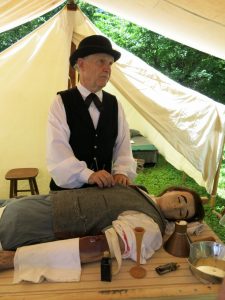 Myths and Truths: Civil War Battlefield Medical Care of the Wounded
Myths and Truths: Civil War Battlefield Medical Care of the Wounded
Speaker: Clarence Hickey
This Civil War presentation will use a life-sized mannequin dressed as a wounded Civil War soldier to discuss and demonstrate some Civil War-era (1860s) battlefield medical procedures and techniques. It will bust some 150 year old myths, such as Civil War soldiers being awake and biting on bullets during surgery. The use of triage, general anesthesia, and pain management will be discussed. Real and reproduction Civil War-era medical instruments will be shown and used, along with a variety of Civil War-era bullets, Minie balls, grape shot, buck shot, clusters, and other slugs (all inert, safe, and with no gun powder) that created many of the battlefield wounds that the surgeons had to treat. The presentation will include discussion of some of the improvements in the practice of medicine and surgery as a result of the experiences and learning during the Civil War, when coupled with the germ theory and other discoveries after the War, resulted in a revolution in medical science, and the age of modern medicine in America. The battlefield medical care offered to America’s military today has its roots firmly planted in the innovative medical care of the American Civil War.
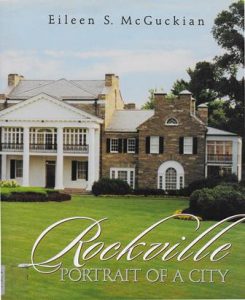 Rockville, Maryland in the Civil War
Rockville, Maryland in the Civil War
Speaker: Eileen McGuckian
As a small county seat located at the intersection of major roads in a slave-holding border state close the nation’s capital, Rockville saw considerable action during the Civil War. Visit places and meet people who faced decisions and experienced wartime during those tumultuous times 150 years ago. (PowerPoint presentation.)

